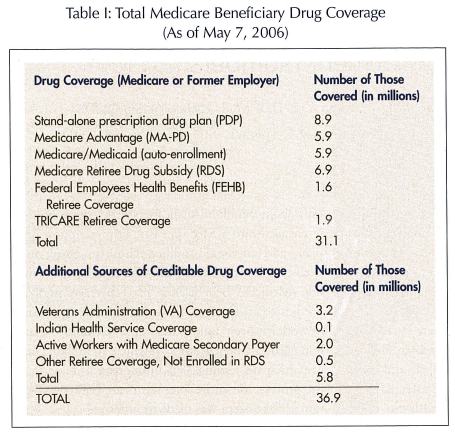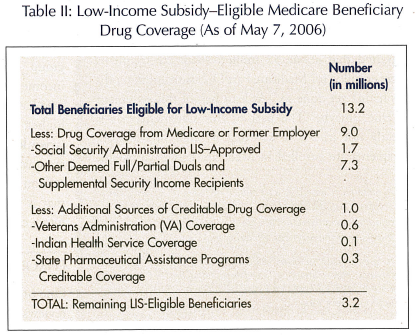ADVERTISEMENT
Medicare Part D Update: Clarifying Medicare Part D Enrollment Numbers
What are the real numbers regarding enrollment and why does it matter? The reason why knowing the real numbers is so important is that failing to do so will result in providers failing to be energized to persuade the 6 million Medicare beneficiaries who did not enroll in Medicare Part D to take advantage of this prescription insurance. In addition, not understanding the true numbers and how many persons have been affected or not affected will have a negative effect on how future health care policy is developed.
THE REAL NUMBERS
So what are the real numbers? There continues to be confusion regarding the numbers of those enrolled and exactly what they are enrolled in. The Philadelphia Inquirer announced that “The Bush administration reported that about 37 million Medicare recipients were enrolled for Medicare Part D, but six million others hadn’t yet done so.” At least half of this statement is true…maybe. The part of this statement that is clearly not true is to say that 37 million Medicare recipients are enrolled in Medicare Part D. Actually, only about 9 million Medicare beneficiaries voluntarily enrolled into a Medicare Part D prescription drug plan, and another 1 million chose to enroll in a Medicare managed care plan. The remaining 27 million Medicare beneficiaries had coverage prior to Medicare Part D. So at the end of the day, a great deal of work has been done to develop a system for 16 million Medicare beneficiaries, of which 10 million chose to participate, leaving 38% unimpressed (Table I). In the process, the entire long-term care (LTC) medication access system was made to suffer.

The reason that I call into question the second half of the administration’s statement regarding enrollment is that many groups such as Families USA (www.familiesusa.org) and the Medicare Rights Center (www.medicarerights.org) are calling into question the number of persons who have not yet enrolled (6 million). They believe this is artificially low, and are finding it difficult to believe that over half of that group is composed of those eligible for the low-income subsidy. They feel that the number of those who have not yet enrolled in Medicare Part D must be higher. Even the Kaiser Family Foundation (www.kff.org) reports that some 13 million persons are unable to be identified as having coverage, with 5 million persons probably having some type of coverage that is not clear enough to place them comfortably into a category (Table II).

ENROLLMENT AFTER MAY 15
One of the real dangers in reporting overly glowing reviews of the number of those who have enrolled in Medicare Part D is the fear that it will put providers in a complacent position where they are no longer aggressively persuading Medicare beneficiaries to enroll in a prescription plan. Medicare Part D is a good deal for almost all Medicare beneficiaries who do not have drug coverage. The reason for this is that it is, after all, prescription drug insurance; as such, it is a protection against the increasingly likely possibility of needing an expensive medication in the future. Unfortunately, many patients are not viewing Medicare Part D as insurance, and now many providers may believe that everyone who should be enrolled has already done so.
The other misunderstanding regarding enrollment is that the enrollment period has passed for everyone. On the contrary, there are three groups for whom the Centers for Medicare & Medicaid Services has provided a special enrollment period so that they can enroll at any time after the May 15 deadline. These groups that have access to enroll at any time include (1) the dual eligibles (those with Medicare and Medicaid); (2) those approved for the low-income subsidy; and (3) certain victims of Hurricane Katrina. The pressure needs to be applied to all of these groups so that they can have the protection and reduction in their out-of-pocket expenses, allowing for increased access to their medically necessary prescriptions.
WHAT SHOULD BE DONE?
Presenting misleading information can also prevent the political will necessary to make adjustments to Medicare Part D so that it can work in a more efficient and effective manner. One example of these adjustments that may not have the political muscle needed because of incorrect information is allowing those entering a LTC facility to also be allowed into the special enrollment period for joining a plan after May 15. Another change would be to allow automatic approval of all Medicare beneficiaries who are eligible for the low-income subsidy, rather than forcing most of them to complete a lengthy Social Security application. And last, as we look toward developing other programs, we should recognize that in the future it may be more efficient and effective to design systems specific for the population in need, such as those without prescription coverage, rather than forcing groups such as those in LTC to change.










